海南大学:《人力资源管理》课程教学课件(PPT讲稿)Chapter 12 Pay-For-Performance and Financial Incentives
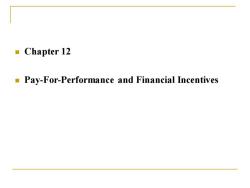
Chapter 12 Pay-For-Performance and Financial Incentives
◼ Chapter 12 ◼ Pay-For-Performance and Financial Incentives
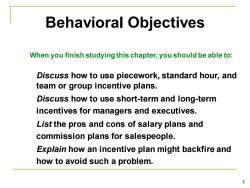
Behavioral Objectives When you finish studying this chapter,you should be able to: Discuss how to use piecework,standard hour,and team or group incentive plans. Discuss how to use short-term and long-term incentives for managers and executives. List the pros and cons of salary plans and commission plans for salespeople. Explain how an incentive plan might backfire and how to avoid such a problem
Behavioral Objectives Discuss how to use piecework, standard hour, and team or group incentive plans. Discuss how to use short-term and long-term incentives for managers and executives. List the pros and cons of salary plans and commission plans for salespeople. Explain how an incentive plan might backfire and how to avoid such a problem. When you finish studying this chapter, you should be able to: 1

Incentives for Operations Employees Piecework Plans Standard Hour Plan Team or Group Variable Pay Incentive Plans 2
Incentives for Operations Employees Piecework Plans Standard Hour Plan Team or Group Variable Pay Incentive Plans 2
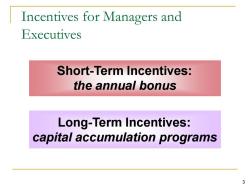
Incentives for Managers and Executives Short-Term Incentives: the annual bonus Long-Term Incentives: capital accumulation programs 3
Incentives for Managers and Executives Short-Term Incentives: the annual bonus Long-Term Incentives: capital accumulation programs 3

Defining the Strategic Context for the Executive Compensation Plan Define the strategic context for the executive compensation program, including the internal and external issues that lace the company and its business objectives-boosting sales abroad,downsizing,and so on. Based on your strategic aims,shape each component of the executive compensation package(base salary,short-term incentives,long-term incentives,and benefits and perquisites),and then group the components into a balanced whole. Create a stock option plan to give the executive compensation package the special character it needs to meet the unique needs of the executives and the company. Check the executive compensation plan for compliance with all legal and regulatory requirements and for tax effectiveness. Install a process for reviewing and evaluating the executive compensation plan whenever a major business change occurs. 4
Defining the Strategic Context for the Executive Compensation Plan Define the strategic context for the executive compensation program, including the internal and external issues that lace the company and its business objectives—boosting sales abroad, downsizing, and so on. Based on your strategic aims, shape each component of the executive compensation package (base salary, short-term incentives, long-term incentives, and benefits and perquisites), and then group the components into a balanced whole. Create a stock option plan to give the executive compensation package the special character it needs to meet the unique needs of the executives and the company. Check the executive compensation plan for compliance with all legal and regulatory requirements and for tax effectiveness. Install a process for reviewing and evaluating the executive compensation plan whenever a major business change occurs. 4

Incentives for Salespeople Salary Plan Commission Plan Combination Plan 5
Incentives for Salespeople Salary Plan Commission Plan Combination Plan 5
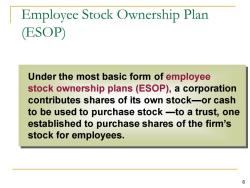
Employee Stock Ownership Plan ESOP) Under the most basic form of employee stock ownership plans (ESOP),a corporation contributes shares of its own stock-or cash to be used to purchase stock-to a trust,one established to purchase shares of the firm's stock for employees. 6
Employee Stock Ownership Plan (ESOP) Under the most basic form of employee stock ownership plans (ESOP), a corporation contributes shares of its own stock—or cash to be used to purchase stock —to a trust, one established to purchase shares of the firm’s stock for employees. 6

Why Incentive Plans Don't Work Performance pay can't replace good management. You get what you pay for. Pay is not a motivator. Rewards punish. Rewards rupture relationships. Rewards can unduly restrict performance. Rewards may undermine responsiveness. Rewards undermine intrinsic motivation
Why Incentive Plans Don’t Work Performance pay can’t replace good management. You get what you pay for. Pay is not a motivator. Rewards punish. Rewards rupture relationships. Rewards can unduly restrict performance. Rewards may undermine responsiveness. Rewards undermine intrinsic motivation. 7
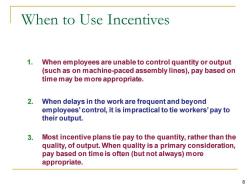
When to Use Incentives 1.When employees are unable to control quantity or output (such as on machine-paced assembly lines),pay based on time may be more appropriate. 2.When delays in the work are frequent and beyond employees'control,it is im practical to tie workers'pay to their output. 3.Most incentive plans tie pay to the quantity,rather than the quality,of output.When quality is a primary consideration, pay based on time is often(but not always)more appropriate
When to Use Incentives When employees are unable to control quantity or output (such as on machine-paced assembly lines), pay based on time may be more appropriate. When delays in the work are frequent and beyond employees’ control, it is impractical to tie workers’ pay to their output. Most incentive plans tie pay to the quantity, rather than the quality, of output. When quality is a primary consideration, pay based on time is often (but not always) more appropriate. 1. 2. 3. 8
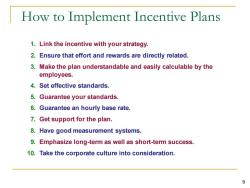
How to Implement Incentive Plans 1.Link the incentive with your strategy. 2.Ensure that effort and rewards are directly related. 3.Make the plan understandable and easily calculable by the employees. 4.Set effective standards. 5.Guarantee your standards. 6.Guarantee an hourly base rate. 7.Get support for the plan. 8.Have good measurement systems. 9.Emphasize long-term as well as short-term success. 10.Take the corporate culture into consideration
How to Implement Incentive Plans 1. Link the incentive with your strategy. 2. Ensure that effort and rewards are directly related. 3. Make the plan understandable and easily calculable by the employees. 4. Set effective standards. 5. Guarantee your standards. 6. Guarantee an hourly base rate. 7. Get support for the plan. 8. Have good measurement systems. 9. Emphasize long-term as well as short-term success. 10. Take the corporate culture into consideration. 9
按次数下载不扣除下载券;
注册用户24小时内重复下载只扣除一次;
顺序:VIP每日次数-->可用次数-->下载券;
- 海南大学:《人力资源管理》课程教学课件(PPT讲稿)Chapter 11 Compensating Employee.ppt
- 海南大学:《人力资源管理》课程教学课件(PPT讲稿)Chapter 9 Appraising and Improving Performance.ppt
- 海南大学:《人力资源管理》课程教学课件(PPT讲稿)Chapter 8 Managing Organizational Renewal.ppt
- 海南大学:《人力资源管理》课程教学课件(PPT讲稿)Chapter 7 Training and Developing Employees.ppt
- 海南大学:《人力资源管理》课程教学课件(PPT讲稿)Chapter 6 Interviewing Candidates.ppt
- 海南大学:《人力资源管理》课程教学课件(PPT讲稿)Chapter 5 Employee Testing and Selection.ppt
- 海南大学:《人力资源管理》课程教学课件(PPT讲稿)Chapter 4 Personnel Planning and Recruiting.ppt
- 海南大学:《人力资源管理》课程教学课件(PPT讲稿)Chapter 3 Job Analysis.ppt
- 海南大学:《人力资源管理》课程教学课件(PPT讲稿)Chapter 2 Equal opportunity and the Law.ppt
- 海南大学:《人力资源管理》课程教学课件(PPT讲稿)Chapter 1 The Strategic Role of Human Resource Management.ppt
- 海南大学:《人力资源管理》课程授课教案 Human Resource Management(负责人:蔡东宏).pdf
- 福州大学:《电子政务》课程教学课件(PPT讲稿)第四讲 电子政务的运作模式.ppt
- 福州大学:《电子政务》课程教学课件(PPT讲稿)第十讲 电子政务结束语.ppt
- 福州大学:《电子政务》课程教学课件(PPT讲稿)第六讲 电子政务法律法规建设.ppt
- 福州大学:《电子政务》课程教学课件(PPT讲稿)第八讲 电子政务关键技术.ppt
- 福州大学:《电子政务》课程教学课件(PPT讲稿)第五讲 电子政务建设与管理.ppt
- 福州大学:《电子政务》课程教学课件(PPT讲稿)第二讲 电子政务概述(主讲:李永忠).ppt
- 福州大学:《电子政务》课程教学课件(PPT讲稿)第九讲 电子政务案例.ppt
- 福州大学:《电子政务》课程教学课件(PPT讲稿)第三讲 电子政务与政府管理创新.ppt
- 福州大学:《电子政务》课程教学课件(PPT讲稿)第七讲 电子政务信息安全.ppt
- 海南大学:《人力资源管理》课程教学课件(PPT讲稿)Chapter 13 Benefits and Services.ppt
- 海南大学:《人力资源管理》课程教学课件(PPT讲稿)Chapter 15 Employee Safety and Health.ppt
- 海南大学:《人力资源管理》课程教学课件(PPT讲稿)Chapter 14 Labor Relations and Collective Bargaining.ppt
- 海南大学:《人力资源管理》课程教学课件(PPT讲稿)Chapter 16 Global Human Resource Management.ppt
- 呼和浩特职业学院:《人力资源管理》课程章节习题与答案.pdf
- 呼和浩特职业学院:《人力资源管理》课程教学实训指导书.pdf
- 呼和浩特职业学院:《人力资源管理》课程教学授课教案(讲义,共七章).docx
- 《人力资源管理》课程教学课件(PPT讲稿)工商管理专业前景.ppt
- 呼和浩特职业学院:《人力资源管理》课程教学课件(PPT讲稿)第一章 序言及概述(主讲教师:张峰).ppt
- 呼和浩特职业学院:《人力资源管理》课程教学课件(PPT讲稿)第三章 工作分析.ppt
- 呼和浩特职业学院:《人力资源管理》课程教学课件(PPT讲稿)第二章 人力资源规划.ppt
- 呼和浩特职业学院:《人力资源管理》课程教学课件(PPT讲稿)第四章 员工招聘与录用.ppt
- 呼和浩特职业学院:《人力资源管理》课程教学课件(PPT讲稿)实训——招聘模拟.ppt
- 呼和浩特职业学院:《人力资源管理》课程教学课件(PPT讲稿)第七章 薪酬管理.ppt
- 呼和浩特职业学院:《人力资源管理》课程教学课件(PPT讲稿)第五章 培训与发展.ppt
- 呼和浩特职业学院:《人力资源管理》课程教学课件(PPT讲稿)第八章 劳动关系管理.ppt
- 呼和浩特职业学院:《人力资源管理》课程教学课件(PPT讲稿)第六章 绩效考核.ppt
- 《推销技巧》课程教学资源(案例集)50万买了那棵.doc
- 《推销技巧》课程教学资源(案例集)不要忘记顾客.doc
- 《推销技巧》课程教学资源(案例集)不要直接指责客户的错误案例.doc
